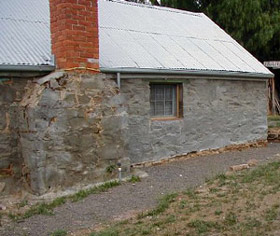
TUTES
COTTAGE



Tutes Cottage
History
The Mount Alexander Shire has one of the finest collections in Victoria of gold heritage places dating from the period 1850 to 1870. A recent discovery has added yet another remarkable place: a five-room cottage constructed of local stone with attached weatherboard kitchen, bathroom and laundry. The cottage has a small garden containing two very old grape vines and fruit trees originated in the great Mount Alexander alluvial goldrush.
From 1855, miners could, under the provisions of their Miner's Right, take out a mining claim and also occupy a Residence Area, a parcel of land not exceeding 20 perches for the purposes of a house and garden. The Miner's Right of the cottage's last occupant, Gladys Power (the now-deceased daughter of a miner) expired in 1996 and the property which straddles a municipal road reserve and a Crown creek reserve, has reverted back to its owners, the Crown. Being always Crown property meant the cottage's various owners made little change to the place resulting in its original architectural style surviving with remarkable clarity.
The first portion of the vernacular stone and timber cottage at 29 Greenhill Avenue, Castlemaine was built by (or for) John Hannan in about 1858. Hannan, a miner from Westport, County Mayo, on Ireland's Atlantic coast, had been in the Castlemaine district since 1856. His wife, Julia, gave birth to a child (the first of six) in 1858 and the 'stone hut' which appeared in that year's rates assessments presumably marked Hannan's passage from itinerant miner to family man.
Hannan built his cottage in rich gold bearing ground called Ten Foot Hill. This area had been rushed early in 1852. Rich pockets of gold were found at a depth of just 10 feet and the locality was thoroughly turned over, from the hill itself right down to Forest Creek. An 1858 painting of Castlemaine from the summit of Ten Foot Hill shows miners still at work on the hill, while the lower slopes and creek flats were peppered with their tents and crude bark huts. It was only 500 metres from Hannan's cottage to the market square at the centre of Castlemaine township, and closer still to the bustling stores and hotels of Urquhart Street. John Hannan's cottage faced north-west, directly towards the original market buildings (behind the remaining market) which were built during the winter of 1858
The cottage's first act of survival was to escape being demolished in 1860 when Forest Creek was diverted. Situated at the foot of Ten Foot Hill, Hannan's cottage was originally approximately 80 metres south of Forest Creek, the tortuous course of which at that time encroached upon the southern edge of the market square. Since its inception in 1856, the Municipal Council had been seeking government assistance to straighten that portion of the creek by means of a channel. Early in 1860 that assistance was forthcoming and, before the end of winter that year, the creek was diverted along the new channel. The creek channel had cut through Hannan's garden and left his cottage teetering on the very edge of its south bank, as it still does today.
The cottage also defied the original route of Greenhill Street laid out on paper in 1862.and forced the street to take a dog-leg: the cottage occupying part road reserve and creek reserve.
But perhaps its greatest survival trick was to stay continuously occupied. After Hannan's death in 1903 the cottage was acquired by James Tute, a miner Following an amendment to the Lands Act in 1935, James Tute, along with most of the other remaining Residence Area holders in Ten Foot Hill applied to purchase their land from the Crown. Tute's application was refused, on the grounds that his Residence Area was entirely on a road reserve. However, a Lands Department officer noted 'the Council are unlikely to force applicant to vacate the area occupied until his very old house is no longer habitable'.
James Tute stayed on, however, and when he died of phthisis ('Miner's Complaint') in 1939, his Residence Area and cottage at 29 Greenhill Street passed to his wife Elizabeth. Elizabeth died in 1973, bequeathing the property to her daughter, Gladys Power. In 1975, Mrs Power sought to have the Residence Area converted to freehold. In refusing her request, the Lands Department cited the same reason given to her father - that the land occupied part of the roadway. Mrs Power lived in the cottage until her death in 1997.
Significance
Tutes Cottage and Garden is a rare artefact of the Victorian gold rush. Established c.1854, the property is an important reminder of the Victorian Government's strategy after the Eureka Rebellion to provide land to its new settlers through the granting miner's residential areas.
From 1855, a Miner's Right entitled the holder of a mining claim to also occupy a parcel of land as a Residence Area, for the purpose of a house and garden. The land on which Tute's Cottage stands was continuously held under a Miner's Right until 1996: only then did it revert to Crown possession. It appears that, because the cottage's various occupants could never aspire to own the land, they were little inclined to make 'improvements' to the structure. As a result, its original architectural style has survived with remarkable clarity and integrity.
The future
Tutes Cottage and Garden is part of the Mount Alexander Diggings Project. It will be used to develop tourism package linking the property to other heritage places such as Castlemaine Art Gallery and Museum, Buda Historic Home and Garden and the remains of Chinese market gardens in the Castlemaine Diggings National Heritage Park.
Tutes conservation and adaptive reuse project has been carefully planned and has already involved an extraordinary amount of community involvement, including many hundreds of hours of voluntary work. The first stage of the project have been published in Heritage Victoria's Inherit magazine and Australian Garden History Society's publication.